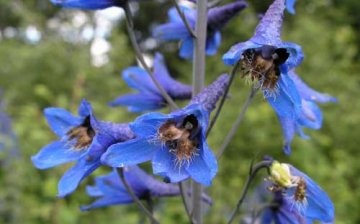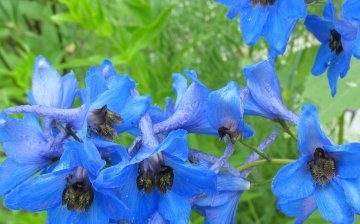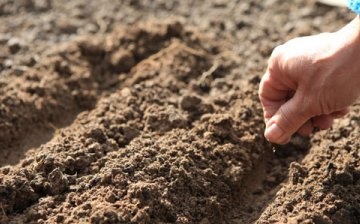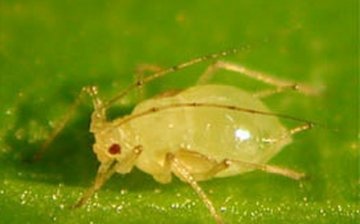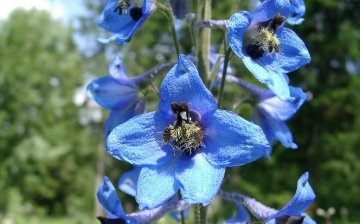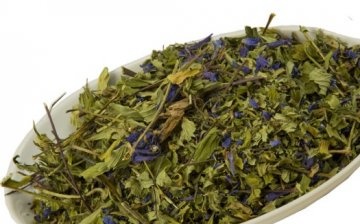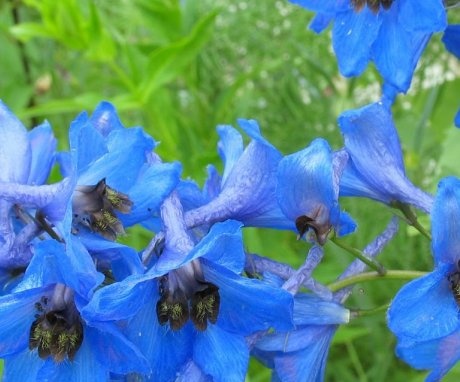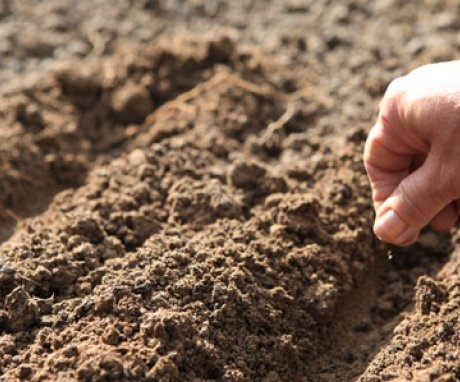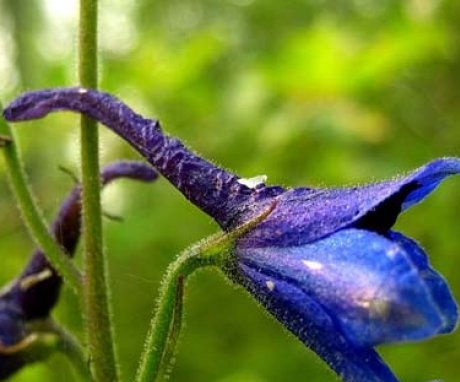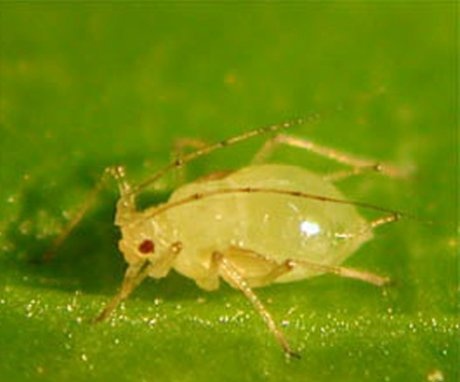Larkspur high - an ornamental and medicinal plant
Many have met this plant with blue flowers in nature, and its decorative analogue, delphinium, decorates flower beds in the garden. But few people know that the flower is good for health and traditional medicine recipes rarely do without it.
Content:
- External structure of high larkspur
- Breeding and rearing methods
- Care advice
- Plant diseases and pests, preventive measures
- How is the plant useful and harmful for humans?
- Traditional medicine recipes using larkspur
External structure of high larkspur
The tall plant, adorned with gorgeous blue flowers, is found in its natural environment throughout Russia, taking a fancy to tall grasses in mixed forests. It is also found in gardens, lawns and flower beds, but already under the name delphinium, or spur.
Many species of larkspur can be found in parks and gardens under the name delphinium.
Larkspur belongs to the Buttercup family, and the long, sometimes up to 4 meters in height, plant stems are visible from afar among the grass. On an erect stem, at the ends of short twigs, there are bright blue flowers with a long hollow spur and a five-leafed calyx. Several stems, they are naked, covered with finger-dissected leaves. After the plant has faded, at the end of summer, bare fruits with scarlet-winged seeds are visible on it. They have the ability to scatter on their own, but seedlings appear rarely and uncommonly.
In the first year of growth, the flower forms stems, and only in the second summer does the budding period begin, flowering, then they harvest medicinal raw materials. Cutting allows new branches to emerge, so you can get another cut over the summer. The plant tolerates winter well even with a small snow cover.
Breeding and rearing methods
Growing a flower is most often done using seeds. Here are the basic rules for planting material:
- It is best to sow the seeds immediately into the ground. The place is selected so that it is clean of weeds, especially those with large rhizomes. To prepare the soil, use deep digging, hot water treatment, introduction organic and mineral fertilizers.
- Seeds for sowing are chosen only fresh, better collected from their plant. To increase their stability, they are kept in the refrigerator for a long time, about two months. If the planting of seeds is planned for the fall, before winter, then stratification it is possible not to carry out.
- Before the planting procedure, the soil is rolled up. The depth of planting seeds in spring is up to three centimeters, before winter - one.
The emergence of seedlings is a signal to transplant... You can separate the small bushes, and in order to better take root, cover them with a plastic bottle. This will help them survive the spring frosts, strengthen the still weak root system.
Propagation by cuttings is also possible for tall larkspur.
Prepare the material in the spring, cutting off the branches by at least 10 centimeters. It is either placed directly in the soil, or first in pots.The basic rule for the rooting of a delphinium is the increased humidity of the earth and air.
Multiply dividing the bush it is also possible, but for this the plant must be at least three years old. Before the procedure, it is dug up and divided so that there is an escape in each part. Activated carbon powder is applied to the damaged parts of the stem, and the rest are thoroughly washed. It is better to keep the bushes separated from each other for three weeks in a warm room, placing them in a container with nutrient soil. And then they just plant the sprouts in a permanent place in the garden.
When planting larkspur, special attention should be paid to the composition of the soil. The plant prefers loose loamy soils, flavored with peat. Soils with low acidity should be fertilized with slaked lime.
Care advice
It can be said about tall larkspur that it is unpretentious, but some care rules are required for:
- Although the plant loves moisture, but watering should be moderate, at the root. And here it is important to ensure that moisture does not get on the leaves and flowers, especially on hot days, otherwise they will get burned.
- Planting larkspur does not tolerate the presence of weeds, therefore weeding, loosening them does not tolerate indifference.
- Top dressing mineral fertilizers necessary during the flowering and pruning period of the delphinium. Spring feeding includes a mixture of potassium chloride (30 grams), the same amount of ammonium sulfate, a little ammonium nitrate (10 grams), superphosphates (70 grams). Fertilizers are covered to a depth of at least six centimeters. Summer dressing consists of potash and phosphate supplements, forty grams each.
- By cutting off all the inflorescences in the fall, you can only strengthen the plant.
- The flower grows well in one place for ten years, then you can transplant it.
- When the plant reaches half a meter in height, you can tie it up with ribbons of cotton fabric to wooden fortifications, fences.
Larkspur is used for decorative landscaping in curbs, in groups on lawns, mixed flower beds in the background. Breeding delphinium varieties with different colors allows its use in various compositions.
Plant diseases and pests, preventive measures
Perennial delphinium can be susceptible to both fungal and viral diseases. When ramulariasis is affected, brown spots with a dark rim and a light center appear on the foliage. Here it is necessary to remove the dead parts, and spray the diseased flower with antifungal drugs.
The appearance of a grayish bloom on all parts of the larkspur is a signal for taking quick measures, for treating the bushes with a foundation or a preparation Topaz.
Many gardeners fight the disease with a copper-soap solution or pollinate with sulfur powder after moistening the plant with water. Viral lesions appear as dark spots on the leaves, after which the greens die off and fall off. And in this case, it is necessary to quickly spray the plantings with a solution of the antibiotic tetracycline, otherwise they will die.
Of the pests for the delphinium, the most dangerous aphid, ticks, caterpillars, slugs. Constant observation of the garden pets will allow you to notice the enemy in time and destroy him. And here they did not come up with anything better than spraying with insecticidal preparations. And large caterpillars, slugs can be collected by hand or put chlorine traps on them.
How is the plant useful and dangerous for humans?
Larkspur high refers to a valuable medicinal raw material, because it is used in pharmacology in full:
- The green part of the plant contains more than one percent of alkaloids - elantine, dolphin. It is they who help relieve a person from severe pain and ailments, acting on the nerve endings, cardiovascular, respiratory system of a person.
- Elantine is one of the curariform alkaloids that the Indians once used to poison arrows.Nowadays, along with anesthesia, they are used in surgical practice to relax the muscles of the skeleton. Substances obtained from larkspur are used to prepare preparations with antimicrobial, analgesic, choleretic effects.
- Plant-based remedies are especially effective in the treatment of whooping cough, jaundice, inflammation of the genitourinary system, respiratory system, stomach, sore throat. In traditional medicine, powders and tablets are used that will help reduce muscle tone in various injuries, lesions of the brain and spinal cord, blood vessels.
- Alternative medicine believes that the remedies from this plant are effective for fractures, rheumatic pains, hence its name - larkspur.
In addition, the flower in solution copes well with harmful insects: flies, cockroaches, garden, garden pests, and by mixing it with salt, they expel parasites from sheep.
But knowing about the poisonous properties of larkspur, one must be careful in its use.
In close contact with it, when the juice accidentally gets on the skin, irritation and redness of the skin may occur. When ingesting infusions and decoctions of herbs, one must be careful in dosing, otherwise serious intoxication of the body may occur, which will lead to difficulty breathing, strong muscle relaxation, a sharp drop in blood pressure, accompanied by vomiting, and stomach pains.
Traditional medicine recipes using larkspur
Here are some recipes for making folk remedies from this wonderful plant:
- A healing drink made from a teaspoon of dried herbs, infused for two hours in half a liter of boiling water, treats migraines, pneumonia, bladder and stomach pathologies. And they take it in half a glass an hour before meals four times a day.
- A decoction of the herb is prepared as follows: a teaspoon of raw materials is poured with a glass of water and boiled over low heat for about 20 minutes, then they insist for another hour. Take one tablespoon for burns, jaundice, hernia three times a day.
- Fractures are effectively treated with larkspur lotions: the roots of the plant are finely cut, poured with boiling water, covering them completely. After 10 minutes, the fabric is impregnated with infusion, folded in the middle of the plant material, applied to the lesion site for 30 minutes. Daily lotions three times can help bone fusion. The same procedures are used to treat burns.
- Alcohol tincture of larkspur roots, used in a few drops, starting from four and gradually bringing them to thirty, before each meal has a positive effect on the body for diseases of the digestive tract, colds, tumors.
Larkspur preparations are contraindicated for people with impaired renal function, myopathy. Any use of folk remedies based on this plant must be approved by a specialist.
More information can be found in the video:



